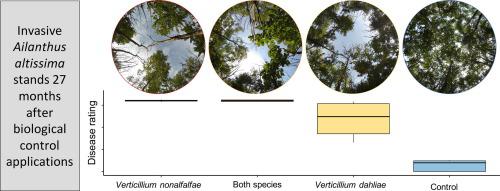当前位置:
X-MOL 学术
›
Biol. Control
›
论文详情
Our official English website, www.x-mol.net, welcomes your feedback! (Note: you will need to create a separate account there.)
Field-inoculated Ailanthus altissima stands reveal the biological control potential of Verticillium nonalfalfae in the mid-Atlantic region of the United States
Biological Control ( IF 4.2 ) Pub Date : 2020-09-01 , DOI: 10.1016/j.biocontrol.2020.104298 Rachel K. Brooks , Kristen L. Wickert , Anton Baudoin , Matt T. Kasson , Scott Salom
Biological Control ( IF 4.2 ) Pub Date : 2020-09-01 , DOI: 10.1016/j.biocontrol.2020.104298 Rachel K. Brooks , Kristen L. Wickert , Anton Baudoin , Matt T. Kasson , Scott Salom

|
Abstract Ailanthus altissima, perhaps the best-known example of an entrenched invasive weed tree in North America, was introduced to the Eastern U.S. roughly 240 years ago. The biological control of A. altissima has been a topic of interest since the discovery of a destructive naturally occurring Verticillium wilt disease of A. altissima in 2002. After nearly 20 years of research, an augmentative commercial release of this disease agent, Verticillium nonalfalfae, could be initiated in the near future. However, a few questions still remain: i) does the interaction of V. nonalfalfae with the less virulent V. dahliae inhibit the biological control effectiveness of V. nonalfalfae, and ii) do climate and A. altissima stand variables affect this biological control’s efficacy? To help answer these questions, a three-year field inoculation study including 3,245 A. altissima trees in 13 sites across four hardiness zones of Pennsylvania and Virginia, U.S. was implemented. Disease progressed and spread at similar rates in A. altissima trees co-inoculated with V. nonalfalfae and V. dahliae as those inoculated with V. nonalfalfae alone, with no indication of disease progression changing in co-inoculated trees. Verticillium dahliae alone resulted in lower levels of disease, and no disease spread. Similar results were seen in a supplemental greenhouse inoculation study. Despite slight regional variation of disease progression and spread correlated to climate or stand variables, V. nonalfalfae always caused severe disease and spread rapidly to other A. altissima trees through the forested plots. Our results support the use of V. nonalfalfae as a biological control agent throughout the mid-Atlantic region of the U.S. regardless of stand and climate variables, and including sites where trees are already infected with V. dahliae.
中文翻译:

田间接种臭椿植株揭示了美国大西洋中部地区黄萎病菌的生物防治潜力
摘要 臭椿可能是北美根深蒂固的入侵杂草树的最著名例子,大约在 240 年前被引入美国东部。自从 2002 年发现了一种具有破坏性的自然发生的 A. altissima 黄萎病以来,对 A. altissima 的生物防治一直是一个令人感兴趣的话题。 经过近 20 年的研究,这种病原 Verticillium nonalfafae 的增强商业发布,可以在近期启动。然而,仍然存在一些问题:i) 紫花苜蓿与低毒力的大丽花弧菌的相互作用是否会抑制紫花苜蓿的生物防治效果,以及 ii) 气候和苜蓿林变量是否会影响这种生物防治的功效? 为了帮助回答这些问题,实施了一项为期三年的田间接种研究,其中包括美国宾夕法尼亚州和弗吉尼亚州四个抗寒区 13 个地点的 3,245 棵 A. altissima 树。与仅接种紫花苜蓿和紫花苜蓿的紫花苜蓿共同接种的 A. altissima 树中,疾病进展和传播的速度相似,但在共同接种的树木中没有迹象表明疾病进展发生了变化。单独的大丽轮枝菌导致较低水平的疾病,并且没有疾病传播。在补充温室接种研究中也看到了类似的结果。尽管与气候或林分变量相关的疾病进展和传播略有区域差异,但紫花苜蓿总是引起严重疾病并通过林地迅速传播到其他 A. altissima 树木。我们的结果支持使用 V。
更新日期:2020-09-01
中文翻译:

田间接种臭椿植株揭示了美国大西洋中部地区黄萎病菌的生物防治潜力
摘要 臭椿可能是北美根深蒂固的入侵杂草树的最著名例子,大约在 240 年前被引入美国东部。自从 2002 年发现了一种具有破坏性的自然发生的 A. altissima 黄萎病以来,对 A. altissima 的生物防治一直是一个令人感兴趣的话题。 经过近 20 年的研究,这种病原 Verticillium nonalfafae 的增强商业发布,可以在近期启动。然而,仍然存在一些问题:i) 紫花苜蓿与低毒力的大丽花弧菌的相互作用是否会抑制紫花苜蓿的生物防治效果,以及 ii) 气候和苜蓿林变量是否会影响这种生物防治的功效? 为了帮助回答这些问题,实施了一项为期三年的田间接种研究,其中包括美国宾夕法尼亚州和弗吉尼亚州四个抗寒区 13 个地点的 3,245 棵 A. altissima 树。与仅接种紫花苜蓿和紫花苜蓿的紫花苜蓿共同接种的 A. altissima 树中,疾病进展和传播的速度相似,但在共同接种的树木中没有迹象表明疾病进展发生了变化。单独的大丽轮枝菌导致较低水平的疾病,并且没有疾病传播。在补充温室接种研究中也看到了类似的结果。尽管与气候或林分变量相关的疾病进展和传播略有区域差异,但紫花苜蓿总是引起严重疾病并通过林地迅速传播到其他 A. altissima 树木。我们的结果支持使用 V。



























 京公网安备 11010802027423号
京公网安备 11010802027423号